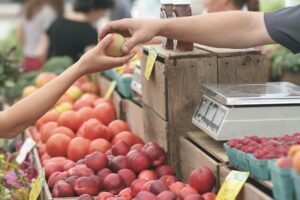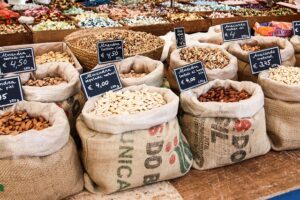
Category: Local Food Delivery and Meal Preparation
Local Food Delivery and Meal Preparation: A Comprehensive Overview
Introduction
In today’s fast-paced world, the way we access and consume food has undergone a significant transformation. The concept of local food delivery and meal preparation has emerged as a game-changer in the culinary landscape, offering both convenience and a deeper connection to our communities. This article aims to provide an exhaustive exploration of this dynamic industry, delving into its various facets, global reach, economic implications, technological innovations, regulatory frameworks, and future prospects. By examining these elements, we can gain valuable insights into how local food delivery services are reshaping the way we eat and interact with our surroundings.
Understanding Local Food Delivery and Meal Preparation
Definition and Core Components
Local food delivery and meal preparation refers to a service that facilitates the direct supply of freshly prepared meals or raw ingredients from local restaurants, catering services, or farmers directly to consumers’ doorsteps. This concept intertwines two primary components:
- Food Delivery: The physical transportation of food items from the source to the customer’s location, often utilizing apps, websites, or telephone ordering systems.
- Meal Preparation: Involves the sourcing and cooking of ingredients, either by professional chefs or through do-it-yourself kits delivered to customers. This aspect focuses on ensuring the quality and freshness of food while catering to diverse dietary preferences.
Historical Context and Significance
The roots of local food delivery can be traced back to traditional neighborhood grocery stores and local restaurants, where people would regularly patronize nearby establishments for their daily culinary needs. However, the modern iteration of this concept has evolved significantly over the past few decades:
- Early 2000s: The rise of the internet and mobile technology laid the groundwork for digital food delivery platforms. Early services primarily focused on restaurant takeout orders, allowing customers to browse menus and place orders online.
- Mid-2010s: With advancements in logistics and a surge in smartphone adoption, food delivery apps gained immense popularity. Platforms like Uber Eats, Deliveroo, and DoorDash entered the market, introducing new levels of convenience and competition.
- Present Day: Today, local food delivery has become an integral part of modern urban life, catering to busy professionals, families, and individuals with diverse dietary requirements. The pandemic further accelerated the trend, highlighting its essential role in providing access to nutritious meals during challenging times.
This service addresses several key aspects:
- Convenience: Customers can enjoy a wide variety of culinary options without leaving their homes or offices.
- Local Support: It fosters a connection between consumers and local businesses, promoting economic growth within communities.
- Nutrition and Dietary Diversity: With the ability to cater to specific dietary needs, these services encourage healthier eating habits and access to diverse cuisines.
- Time Efficiency: Meals can be delivered promptly, allowing individuals to allocate their time for other pursuits.
Global Impact and Trends
Local food delivery has transcended geographical boundaries, captivating cities worldwide and shaping culinary trends:
Regional Diversity
- North America: The United States and Canada have seen a boom in food delivery apps, with major tech companies entering the market. For instance, DoorDash’s acquisition of StubHub expanded its services beyond food, influencing the overall delivery landscape.
- Europe: Cities like London, Paris, and Berlin have embraced local food delivery, with startups offering unique twists on traditional cuisine. Some platforms focus on sustainable sourcing and ethical farming practices, appealing to environmentally conscious consumers.
- Asia: China was an early adopter of food delivery services, with Meituan Dianping dominating the market. In India, Swiggy and Zomato have popularized local food delivery, while Japan’s Foodpanda caters to diverse culinary preferences.
- Latin America and Middle East: These regions are witnessing a surge in food tech startups, often driven by young entrepreneurs who recognize the potential for innovation in this sector.
Key Global Trends
- Digitalization and App-Based Services: The rise of delivery apps has revolutionized the way consumers interact with local food options. These platforms offer real-time tracking, user reviews, and personalized recommendations, enhancing the overall experience.
- Sustainability and Ethical Sourcing: There is a growing demand for sustainable food delivery practices, including eco-friendly packaging, carbon footprint reduction, and support for local farmers and producers.
- Customized Dietary Options: To cater to diverse populations, services are expanding their menus to include vegetarian, vegan, gluten-free, and other specialized dietary choices.
- Subscription Models: Some companies offer subscription plans that provide discounted meals or exclusive access to certain restaurants, encouraging customer loyalty.
- Integrating Meal Kits: The trend of delivering pre-portioned ingredients with recipes is gaining traction, allowing individuals to cook at home while enjoying the convenience of meal delivery.
Economic Considerations
The local food delivery and meal preparation industry has a significant economic impact, influencing various sectors:
Market Dynamics
- Competition: The market is highly competitive, with numerous players, including global tech giants and local startups. This competition drives innovation, improves service quality, and offers consumers more choices.
- Partnerships: Successful delivery services often collaborate with restaurants, cafes, and food halls to expand their reach and attract a diverse customer base.
- Pricing Strategies: Fees vary based on location, order size, and complexity. Dynamic pricing models adjust rates based on demand, ensuring efficient service during peak hours.
Employment and Income Generation
- Job Creation: The industry contributes to employment opportunities, ranging from delivery drivers and restaurant partners to customer support representatives and technology developers.
- Economic Growth: Local food delivery services stimulate economic growth within communities by increasing foot traffic to restaurants and supporting local businesses.
- Revenue Streams: Restaurants benefit from increased sales, while delivery platforms generate revenue through service fees, subscription charges, and advertising.
Regulatory and Legal Aspects
Governments worldwide are grappling with regulating this industry:
- Licensing and Permits: Food delivery services must comply with local health and safety regulations, often requiring specific licenses and certifications for food handling and delivery.
- Tax Implications: Taxes on deliveries vary by region, affecting both the service providers and restaurants.
- Labor Laws: As the industry evolves, there are ongoing discussions about classifying delivery drivers as employees or independent contractors, impacting labor rights and benefits.
Technological Innovations
Technology plays a pivotal role in shaping the local food delivery and meal preparation experience:
- Mobile Applications: User-friendly apps allow customers to browse menus, customize orders, track deliveries, and provide feedback. These platforms often incorporate geolocative services for accurate delivery routing.
- Artificial Intelligence (AI) and Machine Learning: AI algorithms predict customer preferences, optimize route planning, and enhance personalized recommendations, improving overall efficiency.
- Internet of Things (IoT): Smart devices enable automated ordering, inventory management, and real-time monitoring of food preparation and delivery processes.
- Augmented Reality (AR) and Virtual Reality (VR): These technologies offer immersive experiences, allowing customers to virtually explore restaurants or receive AR instructions for meal preparation kits.
- Blockchain: Some companies utilize blockchain technology for transparent supply chain management, ensuring the authenticity of ingredients and maintaining a paperless trail.
Regulatory Frameworks and Challenges
The regulatory environment surrounding local food delivery services varies across regions:
Licensing and Permits
- Health and Safety Regulations: Ensuring food safety is paramount, requiring strict adherence to hygiene standards during preparation and delivery.
- Business Licenses: Delivery services must obtain licenses to operate legally, often involving registration with local authorities.
- Delivery Zone Restrictions: Some cities impose limitations on where delivery drivers can operate, especially in congested urban areas.
Labor and Employment Rights
- Classification of Drivers: The gig economy model presents challenges in terms of labor rights, as many delivery drivers prefer independent contractor status to avoid benefits and taxes associated with employment.
- Minimum Wage and Overtime: Governments are implementing policies to ensure fair compensation for delivery drivers, addressing concerns about exploitative practices.
- Uninsurance and Liability: Issues related to insurance coverage and liability in the event of accidents or property damage during deliveries are being addressed through legislative frameworks.
Data Privacy and Security
As delivery services rely heavily on digital platforms, protecting customer data is crucial:
- Data Breaches: Ensuring secure storage and transmission of sensitive information, such as payment details and personal preferences, is essential to maintaining customer trust.
- Privacy Regulations: Compliance with data privacy laws, like GDPR in Europe or CCPA in California, is mandatory to avoid legal consequences and safeguard consumer rights.
Future Prospects and Innovations
The local food delivery industry is poised for further growth and innovation:
- Personalized Experiences: AI-driven recommendations and predictive analytics will offer tailored meal suggestions based on individual preferences, dietary restrictions, and cultural backgrounds.
- Sustainable Packaging: There will be a greater emphasis on eco-friendly packaging solutions to reduce waste and minimize the environmental impact of deliveries.
- Integrated Meal Solutions: The integration of grocery shopping with meal delivery services is expected to grow, providing customers with comprehensive food solutions for their daily needs.
- Virtual Cooking Classes: Post-pandemic trends suggest an expansion of virtual cooking classes and meal kits, allowing individuals to learn new cuisines while receiving pre-measured ingredients delivered straight to their homes.
- Blockchain-Based Food Traceability: Blockchain technology will enable transparent supply chain management, ensuring food safety and authenticity from farm to table.
Conclusion
Local food delivery and meal preparation have evolved into a dynamic and influential segment of the culinary industry, shaping how we interact with food and local businesses. As technology advances and consumer preferences continue to evolve, this sector will play an increasingly vital role in our daily lives. Navigating regulatory challenges while embracing innovation will be crucial for service providers to ensure sustainable growth and meet the evolving needs of customers worldwide.









